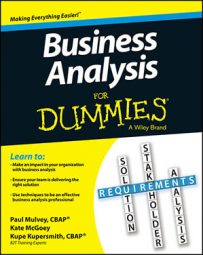The first step in developing questions for your business analysis that really get to the problem or opportunity is to figure out which type of question — “what,” “how,” “why,” “when,” or “where” — you want to ask based on the information you need to obtain.
To determine which kind of question best suits your purposes, consider what you already know, what you don’t know, and what information you need to get started.
“Where” questions
“Where” questions help you understand data sources (“Where is the data kept? Where do you get the data? Stakeholders, where does the data come from?”) and can also help with planning (“Where are those users located?”)
“Where is the data coming from?” Knowing the source of the information can help you plan interfaces or look for alternate sources of data. It can also reveal duplicate sources of data within your organization.
“At what point is the process most inefficient?” This question enables you to pinpoint the location of bottlenecks and other inefficiencies.
Sometimes, you have to be crafty, especially if you’re asking questions whose answers may put people on the defensive, just like “why” questions. When you experience this situation, think about different ways to ask the question, such as “Where is the bottleneck?” or “Where do people have the most problems?” The latter questions are not-so-obvious ways of getting the same information from your stakeholders.
“Where are the stakeholders themselves located?” or “Where are the people I’m eliciting requirements from located?” Knowing the answers to these questions helps you plan your elicitation sessions.
Knowing the proximity of resources and stakeholders is a vital piece of the “how long is this project going to take” equation because this knowledge helps you create an effective and efficient approach for project elicitation.
For example, if many of the resources you need are offsite, you know to add time in for that situation when planning your project. And as the project’s timeline and resource needs increase, so does the budget.
“When” questions
The “when” question gives you an idea of when the problem or the trigger for a process occurs. The answers to “when” questions also give you more clues about how all the different stakeholders and tasks are related — key information for your overall understanding of the project.
“When do you experience the problem?” This question helps you to narrow down the situations in which a problem occurs by asking leading questions. You identify possible triggers while ruling things out.
“When do you perform this process?” This question helps determine the level of effort and priority associated with the request. If the process is performed hundreds of times per day, that process may be higher on the priority list than a process performed once per decade.
“When does the process begin?” This question helps you understand not only the triggers for a process but also the users’ understanding and recognition of the process and what is or isn’t a part of the process.
“How” questions
The “how” question primes the pump for getting down to a solution. The answer to a “how” question helps you understand the current way in which a task or activity is done or the impact a change has to a business area. It’s another layer of detail in your big picture.
“How does this problem affect the way you work?” This information helps you understand the impacts to the business area. Knowing these effects, you can plan your solution and analysis phases and strategy. As you uncover some of the “hows” in the process, you may also identify some stakeholders.
“How will these changes affect your business area?” This question gets to the core of transition requirements. After you know how the specific change affects the stakeholders, you can plan for solutions to help ease the transition and change and account for training, migration, and preparing for the new solution.

